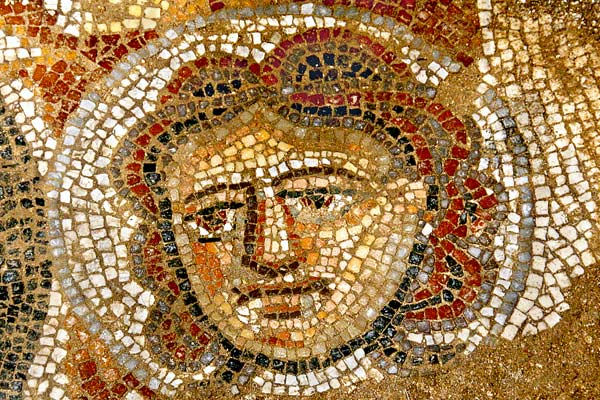
Archaeologists discover surprising mosaic
Published: July 3, 2012
An international team of archaeologists from Canada, Israel, Slovakia, and the United States have discovered a stunning mosaic floor decorating the interior of a monumental synagogue dating to the Late Roman /Byzantine period in Israel.
"It's a bit complicated and technical but the bottom line is we had absolutely no expectation of finding a mosaic floor," said Shaun McKinnon (pictured below). The U of T undergraduate student was working on the dig the day of the discovery.
"We knew, based on excavations last year that this was a synagogue and part of the research for the dig is establishing the date of the synagogue," McKinnon said. "Based on what we thought we knew about this style of building, we were not expecting the mosaic floor at all. And to find one this elaborate and this finely made was also a very big surprise."
The mosaic, which is made of tiny coloured stone cubes of the highest quality, includes a scene depicting Samson placing torches between the tails of foxes (as related in the book of Judges 15) and is dated circa 4th to 6th century Common Era (C.E.). In another part of the mosaic, two – likely female – human faces flank a circular medallion with a Hebrew inscription that refers to rewards for those who perform good deeds.
“This discovery is significant because only a small number of ancient synagogue buildings are decorated with mosaics showing biblical scenes, and only two others have scenes with Samson – one is at another site just a couple of miles from Huqoq,” said project leader Jodi Magness, the Kenan Distinguished Professor in the department of religious studies in the University of North Carolina at Chapel Hill (UNC)’s College of Arts and Sciences.

“Our mosaics are also important because of their high artistic quality and the tiny size of the mosaic cubes," Magness said. "This, together with the monumental size of the stones used to construct the synagogue’s walls, suggest a high level of prosperity in this village, as the building clearly was very costly.”
Michael Chazan, director of the University of Toronto's Archaeology Centre added that “this discovery sets the stage for some great archaeology as the project moves forward. It is terrific that the University of Toronto is part of this effort."
McKinnon, who is pursuing specialists in both archaeology and religious studies, credits Chazan for helping him land a spot on the dig last year. He returned this year, spending the entire month of June at the dig.
"I love to dig so it was just as exciting for me last year as it was this year," McKinnon said. But when another student began uncovering the mosaic, organizers announced the find and everyone stopped digging and gathered around.
"Finding something this cool is basically a once-in-a-career kind of thing and since I wasn't the one who actually found it I'm hoping I'll be the one to find something like this one day," McKinnon said. "But even if this is all I get, that's cool too because this was a very rare find and it was very exciting.
"As far as we knew, this type of synagogue did not have this type of floor - they have unadorned flagstone floors - so the important thing to take away is that what we thought we knew was wrong."
The discovery may change the way archaeologists view synagogues of this type or it may change their understanding of the date of this particular synagogue - either way, it's an important contribution to the conversation, McKinnon said.
Huqoq – the site of the discovery, located about 2.4 kilometres northwest of the Sea of Galilee – is an ancient Jewish village near the modern-day town of Migdal.
In addition to the partner institutions — the Israel Antiquities Authority, UNC, Brigham Young University in Utah, Trinity University in Texas, and the University of Oklahoma — the project was supported by the Centre for Jewish Studies and the Archaeology Centre at the University of Toronto, as well as the Canadian Institute for Mediterranean Studies.
Excavations are scheduled to continue in the summer of 2013.



